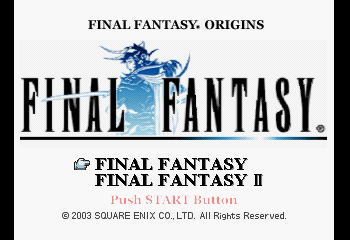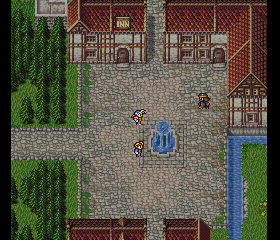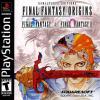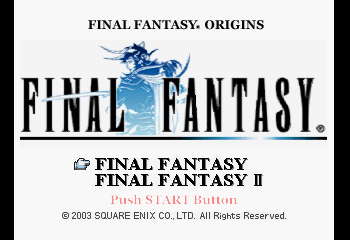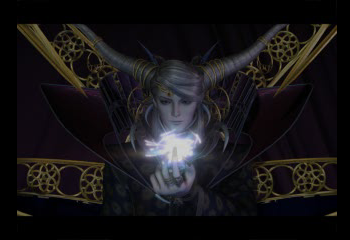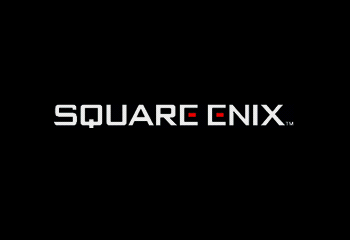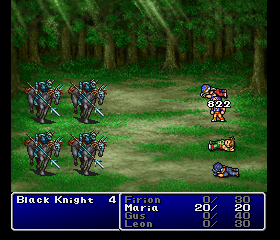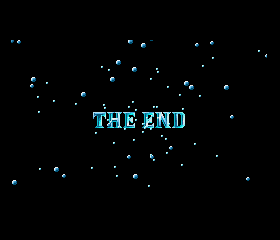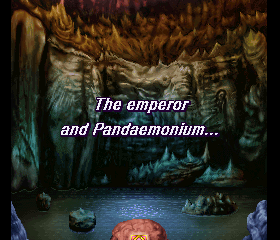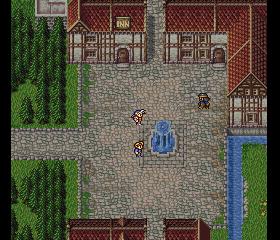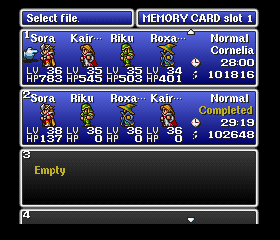Final Fantasy Origins Review by: janus - 9.5/10
Final Fantasy Origins: the Right Adaptation of Great ClassicsFinal Fantasy. Just by the name, RPG gamers know they are in for quality gaming, great music and memorable gameplay. And thanks to modern technology, it’s even possible to recycle old games and make them much, much more attractive and show “youth” where their gaming addiction started. This is just what Square Enix did back in 2003 by upgrading its two first classics, Final Fantasy I and Final Fantasy II, and putting them into this wonderful game, Final Fantasy Origins.
Graphics: 10/10
While obviously not up to Final Fantasy VIII or Final Fantasy X, which was released in 2002, FFO still has very nice graphics compared to their NES versions.
Both games have been upgraded to 16-bits quality making them much more appealing to the eye – at least for me since I grew up with 16-bits. Characters now have human proportions and real features rather than being blobs of pixels with oversized heads, monochromatic clothes and indistinguishable features; hell the graphics are mostly better than Final Fantasy VI! For example, Maria in FF 2 now looks more like Lara Croft with a sporty tank rather than looking like she wears a tiny bikini. The upgrade also affects the way they move; you can actually dash! The feature was only introduced in Final Fantasy V, and only if you had the right character class/ability. This makes moving around much less of a drag.
Towns, dungeons and overworld maps have also been nicely redone. For FF 1 the change is quite dramatic. You can actually explore shops, inns and churches instead of just popping up to the counter. While they are usually empty, it gave more life to an otherwise empty game – the church was the best improvement with the benches and light from the stain glass. Houses are finely drawn and detailed and the dungeons show better texture with their stalactites; the grass is also much greener in towns. The most stunning improvement in FF 2 can be seen in Castle Pandemonium with its crystal floors. Of course, towns have better details and the overworld elements (including the snow) are better-drawn too.
Battles have dramatically improved too. Whatever background you fight from can be seen everywhere, not just at the top of the screen. Fighting in a forest was the best one with the trees hiding the sun. Your fighters move more fluidly and their physical attacks are up to the level reached in Final Fantasy VI – you see the weapon but they don’t go hit the enemy directly as in Phantasy Star II and IV. Magic too is better drawn and it can attack every enemy at any level. And in FF 2, magics that didn’t have graphics like Ultima and Holy now have some, making the game more complete.
Finally, your enemies are much-better drawn. They are as static as ever but at least you see them better. In FF 2 especially, Riders have a more realistic stance; instead of having the horse on its hind legs, you see the knight in an attack position ready to charge at you. However, I think the original Golems and Giants looked better.
Oh, and there are also intro movies to both games. The FF 2 is very appropriate as it shows the team escaping a burning Fynn and getting caught up by Riders, while FF 1 merely illustrates the intro text with the faltering world.
Music: 9/10
In addition to much better graphics, FFO also boasts very impressive improved music.
The best changes are in FF 1. The overworld theme is now absolutely epic – I wish that a future orchestration be based on the FF O version –, the town theme has a very realistic and soothing guitar playing, Castle Cornelia now has a life-like harpsichord playing and Matsoya’s Cave just sounds better now. While smoother, the dungeon music still keeps some mystery to it (the volcano theme is much more elaborate, with more distinctive parts) while the final dungeon theme is both dramatic and beautiful with its harp/violin tones. Finally, the battle themes have been improved and expanded. On the NES there was only one theme; in FFO there four, including two different boss themes.
FF 2 also boasts some very nice improvements. They mainly come from more thorough themes that take longer to loop like the Rebel’s Theme, the Overworld Theme and Ancient Castle (although the longer loop features drums that seem out-of-place with the rest). The battle themes are now much more distinct, with the addition of an “ordinary” boss theme and a separation between the final boss theme and the “major boss” theme (in the Jade Passage and Castle Pandemonium). The latter is quite epic while the former sounds very dramatic with its brass tones and loud violins (the intro to the track gives a hint of the “epicness”. Slight caveat: I thought the dungeon theme, and especially Magician Tower, sounded better on the NES. The FF O version is more realistic, but the violins for the dungeon and the harpsichord for the tower just didn’t carry the same feelings. Also, the ordinary battle theme could have been done better; the intro doesn’t sound very Final Fantasy and it doesn’t flow as well. But Temptation of a Princess is much more elaborate, revealing its true inspiration: Tchaikovsky’s Swan Lake. The Chocobo theme also kept its original length but the guitar used to play it makes the theme even better.
Finally, sound effects have also improved nicely. Your weapons (even your fists) sounds much more realistic – the bow in FF 2 doesn’t have the same high-pitch sound. The magic (fire, ice, lighting, cure, etc.) has been standardized to 16-bits level which, at least for FF 2, is a slight setback – magic had 16 levels, so Fire 16 sounded quite hot. There is no annoying transition sound between screens and there are even realistic-sounding doors.
Addictiveness: 8/10
While both games are mere “translations” to 16-bits, I still got hooked to both games – it was actually my first playing for both games.
Of course, the music and graphics had a lot to do with it. It was about as appealing as playing Final Fantasy V (although the graphs in FF O are more colorful) as the maps didn’t have a ¾ view like FF VI. Nevertheless, I enjoyed the little that FF 1 had to offer and worked my way through self-mutilation in FF 2.
What also kept my interest was this “sidequest” where the game keeps a record of the monsters and bosses you kill. Once you do, you can see the monsters’ stats and weaknesses. This will prove to be a challenge in FF 2 as many of them can only be found in Castle Pandemonium, and only with great luck. Will you be able to find the Iron Giant?
Story: 7/10
It would have been higher had FF 1’s story been improved a little.
Indeed, the story is simplistic: a team of four warriors mysteriously appears when the fire weakens, the wind stops, the earth starts to rot and the water gets wild. They, of course, each carry four mysterious jewels whose light has faded away. They are, of course, THE warriors of legends that will come in times of crisis. They have no development whatsoever, nor do they even talk. And the villain’s story at the very end just doesn’t make any sense.
FF 2, on the other hand, was much more elaborate especially for its time. Yes, it ends up being a save-the-world quest, but the way you get there is proportionally as elaborate as FF IV. You follow the adventures of four youth, including a brother and a sister and two of their friends, who nearly get killed by fierce Imperial Soldiers. Fortunately, they get saved by the Rebels who want to stop the evils of the Empire. Through your quest, you will meet different characters, all of whom do have a little story following them – the main characters also have a story of their own. All the secondary characters will play a vital role in your quest; so vital that many of them will die at an alarming rate so you can pursue your quest, something not seen in any Final Fantasy nor in many RPGs.
Depth: 8/10
Again, with respect to the original game, FF 1 and FF 2 had quite a bit to offer.
While FF 1 is pretty straightforward with only one real sidequest (getting the rat tail so you can promote your characters), the dungeons are still pretty elaborate and will keep you busy for a while. Also, before you actually start your quest of reviving the crystals you need to accomplish a few quests first like saving the princess from Cornelia, help Matsoya get her eye back and wake up the Elf Prince.
FF 2, on the other end, has a much deeper story and, accordingly, much more to offer. The dungeons are larger and have more deadends, the world map is much larger can takes a very long time to cross – you sometimes need special means of transportation like a snow hovercraft – and non-playing characters like Princess Hilda get a lot of attention. FF IV and V didn’t have NPC (excluding villains) receiving so much attention. There is also a system of passwords that will help you progress through the game and get more information out of people – saying Wild Rose will reveal supporters of the Rebels and those people will give you more information.
Difficulty: 5/10
With the modernization of the game came a complete transformation of the difficulty level. For starters, you can make instant saves (on the PSX’ RAM), which saves you time and lets you plan ahead should you take the wrong detour. Also, both games have roll-over attacks and magic, meaning that you don’t have to plan way ahead if you don’t want to hit and miss. However, if you like challenges, you can turn the option off.
In FF 1 increasing your level has become incredibly easy. You can easily reach level 5-7 before fighting Garland, whereas in the NES version you could barely make it to level 2 or 3. Things are also cheaper, so you don’t need $50,000 to get level 5 magic after you barely got the Earth Crystal shining again. Also, letting you attack/heal everyone whenever does help with fighting.
In FF 2, you still have to self-mutilate in order to increase your stats quickly and that is still very annoying. And since your inventory is limited, you won’t be able to carry that many weapons to train with. Ditto for magic: in order to have stronger spells, you need to use them over and over again. What’s worse is that the number of magic points you need increases with the strength of the spell. And since you only start with five mp, you’re in for a very, very long grinding if you want your magic to reach its peak. There are also quite a few trapped treasure chests, and sometimes with very fierce monsters (like the Giant inside a Warship chest) that will knock you out. Finally, the overworld difficulty level is very uneven; you mostly get level-1 monsters around Fynn and Altea until you complete the Tower of Mysidia. After this event, they suddenly become much stronger.
However, the game can be ridiculously easy if you can get the Blood Sword, which absorbs hit point from all living monsters including the final boss. Also, everyone can use everything (spells and weapons) which can save of purchasing cost.
In short, these “definitive versions” of Final Fantasy I and II are worth your while. They have beautiful 16-bits graphics and outstanding music, the difficulty level has become more reasonable and you can finally see where so many of the names (Crescent Island, Ultima, Chocobo, Cid) come from. That feature letting you see all the monsters you confronted is a nice addition and an additional challenge for you.
Graphics
10 Sound
9 Addictive
8 Depth
8 Story
7 Difficulty
5


 User Notice
User Notice 
